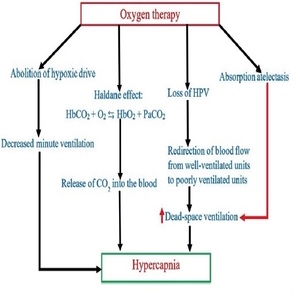Oxygen-induced hypercapnia: physiological mechanisms and clinical implications

Submitted: August 8, 2022
Accepted: October 24, 2022
Published: November 18, 2022
Accepted: October 24, 2022
Abstract Views: 20451
PDF: 4851
Publisher's note
All claims expressed in this article are solely those of the authors and do not necessarily represent those of their affiliated organizations, or those of the publisher, the editors and the reviewers. Any product that may be evaluated in this article or claim that may be made by its manufacturer is not guaranteed or endorsed by the publisher.
All claims expressed in this article are solely those of the authors and do not necessarily represent those of their affiliated organizations, or those of the publisher, the editors and the reviewers. Any product that may be evaluated in this article or claim that may be made by its manufacturer is not guaranteed or endorsed by the publisher.
Similar Articles
- Archana Baburao, Poonam Maurya, Amulya Chakenahalli, Huliraj Narayanswamy, A rare cause of bilateral pleural effusion – desmoplastic small round cell tumor , Monaldi Archives for Chest Disease: Vol. 92 No. 2 (2022)
- Karina Vieira da Costa, Iara Tainá Cordeiro de Souza, João Victor dos Santos Felix, Celso Brendo Furtado Brandão, Vanessa Michelle de Souza Fernandes, Andressa Bomfim Lugon Favero, Maria Lucrécia de Aquino Gouveia, Dyego Tavares de Lima, José Heriston de Morais Lima, Rafaela Pedrosa, Tatiana Onofre, Geraldo Eduardo Guedes de Brito, Eduardo Eriko Tenorio de França, Efficacy of a rehabilitation protocol on pulmonary and respiratory muscle function and ultrasound evaluation of diaphragm and quadriceps femoris in patients with post-COVID-19 syndrome: a series of cases , Monaldi Archives for Chest Disease: Vol. 93 No. 1 (2023)
- Kamal Kant Sahu, Ajay Kumar Mishra, Amos Lal, COVID-2019: update on epidemiology, disease spread and management , Monaldi Archives for Chest Disease: Vol. 90 No. 1 (2020)
- Ram Niwas, Gopal Chawla, Puneet Pareek, Nishant Kumar Chauhan, Naveen Dutt, Revisiting bronchoscopic intratumoral chemotherapy in malignant central airway obstruction via EUS-B approach and its review of literature , Monaldi Archives for Chest Disease: Vol. 90 No. 4 (2020)
- Carla Simonelli, Mara Paneroni, Aubin Georges Fokom, Manuela Saleri, Ilaria Speltoni, Irene Favero, Francesca Garofali, Simonetta Scalvini, Michele Vitacca, How the COVID-19 infection tsunami revolutionized the work of respiratory physiotherapists: an experience from Northern Italy , Monaldi Archives for Chest Disease: Vol. 90 No. 2 (2020)
- Neeraj Kumar Gupta, Rohit Kumar, Harsh Vardhan Puri, Nitesh Gupta, Siddharth Raj Yadav, Pranav Ish, Chest percussion, a common yet underutilized art , Monaldi Archives for Chest Disease: Vol. 90 No. 3 (2020)
- Alberto Cester, Monica Maselli, Francesco Bolzetta, How to define the therapeutic limits , Monaldi Archives for Chest Disease: Vol. 87 No. 2 (2017)
- Gopal Chawla, Ram Niwas, Nishant Kumar Chauhan, Naveen Dutt, Taruna Yadav, Priyank Jain, Pancreatic pleural effusion masquerading as right sided tubercular pleural effusion , Monaldi Archives for Chest Disease: Vol. 89 No. 3 (2019)
- Vishal Chopra, Baljeet Singh Virk, Siddharth Chopra, Monika Bansal, Jain Chungath, Application of CBNAAT (Xpert MTB/RIF assay) in new smear negative pulmonary tuberculosis patients , Monaldi Archives for Chest Disease: Vol. 90 No. 1 (2020)
- Angelica Cersosimo, Gianmarco Arabia, Enrico Vizzardi, Marco Metra, Rapid progression of pulmonary artery dilatation in pulmonary hypertension , Monaldi Archives for Chest Disease: Vol. 93 No. 2 (2023)
<< < 49 50 51 52 53 54 55 56 57 58 > >>
You may also start an advanced similarity search for this article.

 https://doi.org/10.4081/monaldi.2022.2399
https://doi.org/10.4081/monaldi.2022.2399





